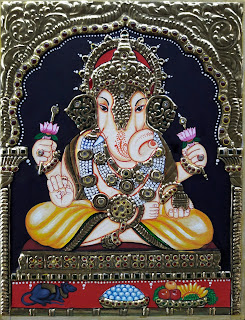History of Tanjore Paintings
Tanjore painting is an art in Tamil Nadu, it is flourished from a town Thanjavur anglicized as Tanjore in Tamil Nadu known for its art and holds unique history in culture of south India. Classical Tanjore paintings, came into being in late 16th century. The art mainly classical music and dance drew a lot of attention back in 1600 AD during the times of Vijayanagara Rayas. The Maratha rule of Tanjore lasted for about 2 centuries from the late 16th century after the Vijayanagara Rayas and during this time these paintings gained popularity. The early paintings were embellished with real Diamonds and other precious stones, Semi precious and artificial stones gained popularity only in later periods.
Tanjore Painting is perfect for Gifting:
Tanjore paintings have become one of the most sought out item in galleries of India and abroad and is definitely worth gifting one to your close ones. Such gifts are always highly appreciated for it would last for generations. It would undoubtedly increase the beauty of a house.
Making of Tanjore Painting :
Of the numerous steps involved in the making of a Tanjore Painting, the first involves drawing of the preliminary sketch of the image on the base. The base is made up of a cloth, which is pasted over a wooden base. The second step consists of mixing chalk powder or zinc oxide with water-soluble adhesive and applying it on the base. Thereafter, the drawing is made and ornamented with cut glass, pearls and even semi-precious stones. Laces or threads may also be used to decorate the painting. To further augment the effect, wafer thin sheets of gold are pasted in relief on some parts of the painting, while the other parts are painted in bright colors.
Types of Designs in Tanjore Paintings:
Chettinad Tanjore Paintings:
Originated in Thanjavur, city in Tamilnadu. Generally with thick lines, bold colors, appropriate shapes designed keeping in mind the balance of every line of the painting. Appropriate colors are used. No question of “out of shape” painting. Chettinad style is live from around 1600 A.D.
Mysore Tanjore Paintings:
Originated in Mysore, a city in Karnataka. These paintings have delicate lines, intricate brush strokes, graceful delineation of figures, mostly of gods and goddesses and the discreet use of bright vegetable colors and lustrous gold leaf make these paintings speak life of 2nd century B.C. to 7th century A.D. specially designed to inspire the feeling of devotion.
Other Paintings:
Different varieties of paintings ranging from Basohli, Pichwai, Marble, Miniature, Water colors, Glow paintings, etc are also Indian and needs more attention.
www.tmpooja online shopping.com
Our Other Topics:








